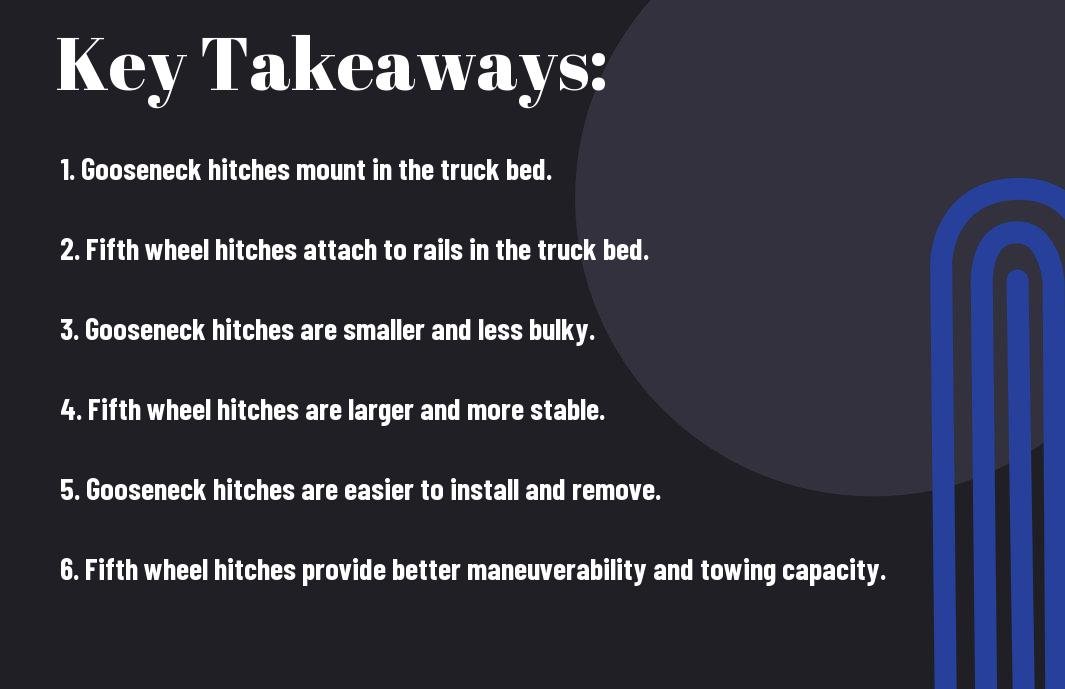Have you ever wondered whether you should choose a gooseneck or a fifth wheel hitch for your towing needs? Understanding the differences between these two types of hitches can be crucial in ensuring a safe and efficient towing experience. While both hitches are commonly used for towing heavy loads, they have distinct differences that you should be aware of before making a decision. In this blog post, I will discuss the key differences between a gooseneck and a fifth wheel hitch, as well as the advantages and disadvantages of each, so that you can confidently choose the best option for your specific towing requirements.
Key Takeaways:
- Mounting Location: A gooseneck hitch mounts in the bed of the truck, while a fifth wheel hitch mounts above the bed of the truck.
- Connection Point: A gooseneck hitch connects to a ball in the truck bed, while a fifth wheel hitch connects to a kingpin on the trailer.
- Maneuverability: A gooseneck hitch allows for better maneuverability, especially when towing larger trailers.
- Weight Capacity: A fifth wheel hitch typically has a higher weight capacity compared to a gooseneck hitch.
- Trailer Compatibility: Gooseneck hitches are more versatile and can accommodate a wider range of trailers, while fifth wheel hitches are designed specifically for heavy-duty trailers.
- Installation Process: Installing a gooseneck hitch generally requires less modification to the truck bed compared to a fifth wheel hitch.
- Cost: Fifth wheel hitches are often more expensive than gooseneck hitches due to their specialized design and higher weight capacity.

The Gooseneck Hitch
Obviously, the gooseneck hitch is a popular choice for towing heavy loads, especially in the case of horse trailers, RVs, and industrial equipment. But what exactly sets it apart from a fifth wheel hitch? Let’s dive into the details.
Definition and Design
The gooseneck hitch is named for its design, which resembles the neck of a goose. It is typically installed in the bed of a pickup truck and uses a hitch ball mounted in the center of the truck bed. This design allows for a tighter turning radius compared to a fifth wheel, and also allows for a more stable towing experience.
Advantages of Gooseneck Hitches
One of the main advantages of a gooseneck hitch is its ability to handle heavier loads. This makes it a popular choice for those who need to tow large and heavy trailers, such as horse trailers or industrial equipment. Additionally, the design of the gooseneck hitch allows for better weight distribution, which can lead to a smoother and more stable towing experience.
Potential Drawbacks
While gooseneck hitches have many advantages, there are also some potential drawbacks to consider. One of the main drawbacks is that the installation of a gooseneck hitch requires modifications to the truck bed, which can be costly and time-consuming. Additionally, the placement of the hitch ball in the center of the truck bed can limit the available cargo space.
The Fifth Wheel Hitch
Keep in mind that a fifth wheel hitch is a type of hitch used for towing heavy loads. It is commonly used for RVs, large trailers, and other heavy-duty towing needs. This type of hitch is designed to handle heavier loads than a traditional ball hitch, providing greater stability and control while towing. When properly installed, a fifth wheel hitch can offer a number of advantages for towing heavy loads.
Definition and Design
The fifth wheel hitch is named after the type of coupling used to connect the trailer to the towing vehicle. This coupling consists of a large, flat plate mounted in the bed of the truck, and a kingpin on the trailer that locks into the plate. This design allows for a tighter turning radius and more stability when towing heavy loads, making it a popular choice for towing RVs and large trailers. The hitch is usually mounted in the bed of a pickup truck, providing a secure attachment point for the trailer.
Advantages of Fifth Wheel Hitches
One of the key advantages of a fifth wheel hitch is its ability to handle heavier loads with greater stability. The design of the hitch allows for more weight to be placed over the rear axle of the towing vehicle, which can improve handling and reduce the likelihood of swaying or fishtailing while towing. Additionally, the design of the hitch allows for a tighter turning radius, making it easier to maneuver the trailer in tight spaces.
Potential Drawbacks
While fifth wheel hitches offer many advantages, there are also some potential drawbacks to consider. One potential drawback is the installation process, which typically requires mounting the hitch in the bed of the truck. This can be a more involved process than installing a traditional ball hitch and may require professional installation. Additionally, the hitch takes up space in the bed of the truck, limiting the available cargo space for other items.
It’s important to carefully consider the specific towing needs and capabilities of your vehicle before deciding on a fifth wheel hitch.
Comparing Gooseneck and Fifth Wheel Hitches
After deciding to invest in a hitch for your towing needs, you may be wondering what the difference is between a gooseneck and a fifth wheel hitch. To help you make an informed decision, it is important to compare the two options based on various factors such as towing capacity, maneuverability, ease of use, and cost considerations.
Towing Capacity and Compatibility
When it comes to towing capacity, fifth wheel hitches typically offer higher weight ratings compared to gooseneck hitches. This makes them suitable for towing heavier loads such as large trailers and RVs. Additionally, fifth wheel hitches provide better stability and control, especially when towing on uneven terrains. On the other hand, gooseneck hitches are known for their compatibility with flatbed trailers and offer a tighter turning radius, making them more maneuverable in tight spaces. Consider the weight of your trailer and the type of towing you will be doing to determine the best option for your needs.
Maneuverability and Stability
When it comes to maneuverability, gooseneck hitches have an advantage due to their design, which allows for a tighter turning radius. This makes them more suitable for navigating through narrow spaces and making sharp turns. However, fifth wheel hitches provide better stability and control, especially when towing heavier loads. The design of a fifth wheel hitch distributes the weight more evenly over the truck bed, reducing the chances of sway and instability during towing. Consider the type of roads and terrains you will be traveling on to determine which hitch offers the best balance of maneuverability and stability for your needs.
Ease of Use and Installation
Both gooseneck and fifth wheel hitches are known for their ease of use and installation, but there are some differences to consider. Gooseneck hitches are easier to install on the truck bed, requiring a simpler installation process compared to fifth wheel hitches. However, fifth wheel hitches offer easier coupling and uncoupling, making them more convenient for frequent towing. Consider your towing frequency and the need for quick coupling and uncoupling to determine which hitch is more suitable for your convenience.
Cost Considerations
When considering the cost of a gooseneck versus a fifth wheel hitch, it’s important to factor in the initial purchase price as well as any additional installation or maintenance costs. Gooseneck hitches are generally more affordable than fifth wheel hitches, making them a cost-effective option for those on a budget. However, it’s important to consider the long-term costs, such as maintenance and potential upgrades, to ensure that you are making the most cost-effective choice for your towing needs.
Conclusion
On the whole, understanding the difference between a gooseneck and a fifth wheel hitch is essential for anyone looking to tow a trailer. You now know that a gooseneck hitch is connected in the truck bed and requires a specific type of trailer, while a fifth wheel hitch mounts above the truck bed and is compatible with various types of trailers. Considering your towing needs and the right hitch for your vehicle will ensure a safe and successful towing experience.
FAQ
Q: What is the difference between a gooseneck and a fifth wheel hitch?
A: A gooseneck hitch is designed to be mounted in the bed of a truck and uses a ball and coupler connection, while a fifth wheel hitch attaches to a set of rails and uses a kingpin and jaw connection.
Q: Can a gooseneck hitch be converted to a fifth wheel hitch?
A: Yes, there are adapters available that allow a gooseneck hitch to be converted to a fifth wheel hitch, providing more versatility for towing different types of trailers.
Q: What are the advantages of a gooseneck hitch over a fifth wheel hitch?
A: Gooseneck hitches allow for tighter turning radiuses, provide better weight distribution, and are generally more affordable than fifth wheel hitches.
Q: Are fifth wheel hitches more stable than gooseneck hitches?
A: Yes, fifth wheel hitches provide a more stable and secure towing experience, especially when towing larger and heavier trailers. The design of the kingpin and jaw connection offers increased stability and control.
Q: Which type of hitch is better for towing heavy loads?
A: For towing heavy loads, a fifth wheel hitch is generally recommended due to its superior stability and weight-bearing capabilities. However, gooseneck hitches can also handle heavy loads effectively, so the choice ultimately depends on individual towing needs and preferences.
